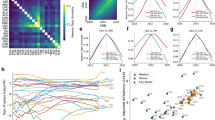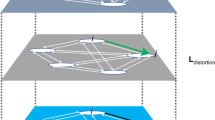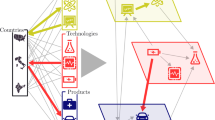Abstract
Science is essential to innovation and economic prosperity. Although studies have shown that national scientific development is affected by geographic, historic and economic factors, it remains unclear whether there are universal structures and trajectories of national scientific development that can inform forecasting and policy-making. Here, by examining the scientific ‘exports’—publications that are indexed in international databases—of countries, we reveal a three-cluster structure in the relatedness network of disciplines that underpin national scientific development and the organization of global science. Tracing the evolution of national research portfolios reveals that while nations are proceeding to more diverse research profiles individually, scientific production is increasingly specialized in global science over the past decades. By uncovering the underlying structure of scientific development and connecting it with economic development, our results may offer a new perspective on the evolution of global science.
This is a preview of subscription content, access via your institution
Access options
Access Nature and 54 other Nature Portfolio journals
Get Nature+, our best-value online-access subscription
$29.99 / 30 days
cancel any time
Subscribe to this journal
Receive 12 digital issues and online access to articles
$119.00 per year
only $9.92 per issue
Buy this article
- Purchase on Springer Link
- Instant access to full article PDF
Prices may be subject to local taxes which are calculated during checkout





Similar content being viewed by others
Data availability
Data used in this study are available at https://figshare.com/articles/journal_contribution/Untitled_Item/13623035/3
Code availability
The code used for data processing and analysis is available at https://github.com/yy/national-science-exports
References
Publications Output: U.S. Trends and International Comparisons (National Science Board, 2019).
Tollefson, J. China declared world’s largest producer of scientific articles. Nature 553, 390–390 (2018).
Zhou, P. & Leydesdorff, L. The emergence of China as a leading nation in science. Res. Policy 35, 83–104 (2006).
Noorden, R. V. Science in East Asia—by the numbers. Nature 558, 500–501 (2018).
Li, K.-W. Capitalist Development and Economism in East Asia: The Rise of Hong Kong, Singapore, Taiwan and South Korea (Routledge, 2002).
Livingstone, D. N. Putting Science in its Place: Geographies of Scientific Knowledge (Univ. Chicago Press, 2010).
Seth, S. Putting knowledge in its place: science, colonialism, and the postcolonial. Postcolonial Stud. 12, 373–388 (2009).
Kozlowski, J., Radosevic, S. & Ircha, D. History matters: the inherited disciplinary structure of the post-communist science in countries of central and eastern Europe and its restructuring. Scientometrics 45, 137–166 (1999).
Hidalgo, C. A. et al. in Unifying Themes in Complex Systems IX Proc. Ninth International Conference on Complex Systems (eds Morales, A. J. et al.) 451–457 (Springer International, 2018).
Chinazzi, M., Gonçalves, B., Zhang, Q. & Vespignani, A. Mapping the physics research space: a machine learning approach. EPJ Data Sci. 8, 33 (2019).
Guevara, M. R., Hartmann, D., Aristarán, M., Mendoza, M. & Hidalgo, C. A. The research space: using career paths to predict the evolution of the research output of individuals, institutions, and nations. Scientometrics 109, 1695–1709 (2016).
Boschma, R., Heimeriks, G. & Balland, P.-A. Scientific knowledge dynamics and relatedness in biotech cities. Res. Policy 43, 107–114 (2014).
Stephan, P. How Economics Shapes Science (Harvard Univ. Press, 2012).
Lee, L.-C., Lin, P.-H., Chuang, Y.-W. & Lee, Y.-Y. Research output and economic productivity: a Granger causality test. Scientometrics 89, 465–478 (2011).
Kumar, R. R., Stauvermann, P. J. & Patel, A. Exploring the link between research and economic growth: an empirical study of China and USA. Qual. Quant. 50, 1073–1091 (2016).
Hornyak, T. Chilean research grows despite poor investment. Nat. Index (2016).
Bronfman, L. A panorama of Chilean astronomy. Messenger 107, 14–18 (2002).
Bajak, A. Chile’s chance to embrace science for the twenty-first century. Nature 552, S53–S55 (2017).
Yeom, H. W. South Korean science needs restructuring. Nature 558, 511–513 (2018).
Science and Engineering Indicators 2018 (National Science Board, 2018).
May, R. M. The Scientific Wealth of Nations. Science 275, 793–796 (1997).
Comte, A. The Positive Philosophy of Auguste Comte (C. Blanchard, 1855).
Basalla, G. The spread of western science. Science 156, 611–622 (1967).
Anderson, W. Remembering the spread of western science. Hist. Rec. Aust. Sci. 29, 73 (2018).
Raina, D. From west to non‐west? Basalla’s three‐stage model revisited. Sci. Cult. 8, 497–516 (1999).
Moya-Anegón, F. & Herrero-Solana, V. Worldwide topology of the scientific subject profile: a macro approach in the country level. PLoS ONE 8, e83222 (2013).
Cimini, G., Gabrielli, A. & Labini, F. S. The scientific competitiveness of nations. PLoS ONE 9, e113470 (2014).
Hidalgo, C. A. Economic complexity theory and applications. Nat. Rev. Phys. 3, 92–113 (2021).
Hong, I., Frank, M. R., Rahwan, I., Jung, W.-S. & Youn, H. The universal pathway to innovative urban economies. Sci. Adv. 6, eaba4934 (2020).
Alabdulkareem, A. et al. Unpacking the polarization of workplace skills. Sci. Adv. 4, eaao6030 (2018).
Hidalgo, C. A., Klinger, B., Barabasi, A.-L. & Hausmann, R. The product space conditions the development of nations. Science 317, 482–487 (2007).
Boschma, R. A. & Koen, F. Evolutionary economics and industry location. Rev. Reg. Res. 23, 183–200 (2003).
Boschma, R. A. & Frenken, K. Why is economic geography not an evolutionary science? Towards an evolutionary economic geography. J. Econ. Geogr. 6, 273–302 (2006).
Boschma, R. & Koen, F. in The New Oxford Handbook of Economic Geography (eds Clark, G. L. et al.) 213–229 (Oxford Univ. Press, 2018).
Hidalgo, C. A. & Hausmann, R. The building blocks of economic complexity. Proc. Natl Acad. Sci. USA 106, 10570–10575 (2009).
Boyack, K. W. & Klavans, R. Creation of a highly detailed, dynamic, global model and map of science. J. Assoc. Inf. Sci. Technol. 65, 670–685 (2014).
Boyack, K. W. & Klavans, R. Co-citation analysis, bibliographic coupling, and direct citation: which citation approach represents the research front most accurately? J. Am. Soc. Inf. Sci. Technol. 61, 2389–2404 (2010).
Boyack, K. W., Klavans, R. & Börner, K. Mapping the backbone of science. Scientometrics 64, 351–374 (2005).
Boyack, K. W., Börner, K. & Klavans, R. Mapping the structure and evolution of chemistry research. Scientometrics 79, 45–60 (2009).
King, D. A. The scientific impact of nations. Nature 430, 311–316 (2004).
Bray, F. et al. Global cancer statistics 2018: GLOBOCAN estimates of incidence and mortality worldwide for 36 cancers in 185 countries. CA Cancer J. Clin. 68, 394–424 (2018).
Evans, J. A., Shim, J.-M. & Ioannidis, J. P. A. Attention to local health burden and the global disparity of health research. PLoS ONE 9, e90147 (2014).
World Health Statistics 2018: Monitoring Health for the SDGs (World Health Organization, 2018).
Serrano, M. A., Boguna, M. & Vespignani, A. Extracting the multiscale backbone of complex weighted networks. Proc. Natl Acad. Sci. USA 106, 6483–6488 (2009).
Traag, V. A., Waltman, L. & van Eck, N. J. From Louvain to Leiden: guaranteeing well-connected communities. Sci. Rep. 9, 5233 (2019).
Klavans, R. & Boyack, K. W. The research focus of nations: economic vs. altruistic motivations. PLoS ONE 12, e0169383 (2017).
Fantom, N. & Serajuddin, U. The World Bank’s Classification of Countries by Income (The World Bank, 2016).
Pinheiro, F. L., Hartmann, D., Boschma, R. & Hidalgo, C. A. The time and frequency of unrelated diversification. Res. Policy https://doi.org/10.1016/j.respol.2021.104323 (2021).
Bustos, S., Gomez, C., Hausmann, R. & Hidalgo, C. A. The dynamics of nestedness predicts the evolution of industrial ecosystems. PLoS ONE 7, e49393 (2012).
Gao, J., Zhang, Y.-C. & Zhou, T. Computational socioeconomics. Phys. Rep. 817, 1–104 (2019).
Morrison, G. et al. On economic complexity and the fitness of nations. Sci. Rep. 7, 15332 (2017).
Inglesi-Lotz, R., Balcilar, M. & Gupta, R. Time-varying causality between research output and economic growth in US. Scientometrics 100, 203–216 (2014).
Vinkler, P. Correlation between the structure of scientific research, scientometric indicators and GDP in EU and non-EU countries. Scientometrics 74, 237–254 (2008).
Gelman, A. & Stern, H. The difference between “significant” and “not significant” is not itself statistically significant. Am. Stat. 60, 328–331 (2006).
Krammer, S. M. S. Science, technology, and innovation for economic competitiveness: the role of smart specialization in less-developed countries. Technol. Forecast. Soc. Change 123, 95–107 (2017).
Powell, W. W. & Snellman, K. The knowledge economy. Annu. Rev. Sociol. 30, 199–220 (2004).
Glänzel, W. National characteristics in international scientific co-authorship relations. Scientometrics 51, 69–115 (2001).
Gordin, M. D. Scientific Babel: How Science was Done Before and After Global English (Univ. Chicago Press, 2015).
Éric, A., Étienne, V.-G., Grégoire, C., Vincent, L. & Gingrasb, Y. Benchmarking scientific output in the social sciences and humanities: the limits of existing databases. Scientometrics 68, 329–342 (2006).
Sugimoto, C. R. & Vincent, L. Measuring Research: What Everyone Needs to Know (Oxford Univ. Press, 2018).
GDP (current US$) World Development Indicators (World Bank, 2019); https://data.worldbank.org/indicator/NY.GDP.MKTP.CD?locations=1W
Barber, M. J. Modularity and community detection in bipartite networks. Phys. Rev. E 76, 066102 (2007).
Almeida‐Neto, M., Guimarães, P., Guimarães, P. R., Loyola, R. D. & Ulrich, W. A consistent metric for nestedness analysis in ecological systems: reconciling concept and measurement. Oikos 117, 1227–1239 (2008).
Acknowledgements
L.M., D.M. and Y.Y.A. acknowledges funding support from the Air Force Office of Scientific Research under award no. FA9550-19-1-0391. The funder had no role in study design, data collection and analysis, decision to publish or preparation of the manuscript. We thank S. Milojević, J. Yoon, S. Kojaku, B.-K. Lee, B. Weinberg, P. Stephan, S. Schnell, T. Zhou, J. Huang, J. Gao, Y. Bu, Q. Zhang, B. Uzzi, H. Youn and N. Dehmamy for helpful discussion and comments.
Author information
Authors and Affiliations
Contributions
L.M. and D.M. conceived the study. All authors contributed to the design of the study. V.L. prepared the primary datasets. L.M., D.M., V.L. and Y.Y.A. performed analysis. All authors contributed to the interpretation of the results and writing of the manuscript.
Corresponding author
Ethics declarations
Competing interests
The authors declare no competing interests.
Peer review
Peer review information
Nature Human Behaviour thanks the anonymous reviewers for their contribution to the peer review of this work.
Additional information
Publisher’s note Springer Nature remains neutral with regard to jurisdictional claims in published maps and institutional affiliations.
Supplementary information
Supplementary Information
Supplementary text, Figs. 1–9, Tables 1–7 and references.
Rights and permissions
About this article
Cite this article
Miao, L., Murray, D., Jung, WS. et al. The latent structure of global scientific development. Nat Hum Behav 6, 1206–1217 (2022). https://doi.org/10.1038/s41562-022-01367-x
Received:
Accepted:
Published:
Issue Date:
DOI: https://doi.org/10.1038/s41562-022-01367-x
This article is cited by
-
Citation Elites in Polytheistic and Umbrella Disciplines: Patterns of Stratification and Concentration in Danish and British Science
Minerva (2024)
-
Tectonic shifts in global science: US-China scientific competition and the Muslim-majority science systems in multipolar science
Higher Education (2024)
-
Disciplinary and institutional shifts: decomposing deviations in the country-level proportions of conference papers in Scopus
Scientometrics (2024)
-
Pest management science often disregards farming system complexities
Communications Earth & Environment (2023)



